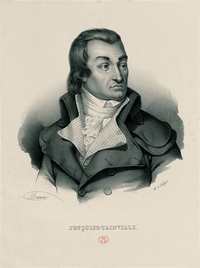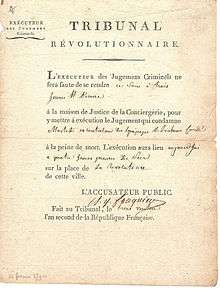Antoine Quentin Fouquier-Tinville
Antoine Quentin Fouquier de Tinville (10 June 1746 – 7 May 1795) was a French prosecutor during the Revolution and Reign of Terror periods.
Antoine Quentin Fouquier de Tinville | |
|---|---|
 Prosecutor during the Reign of Terror | |
| Born | 1746 |
| Died | 7 May 1795 (aged 48–49) Paris, France |
| Cause of death | Guillotine |
| Occupation | Lawyer |
| Signature | |
Biography
Early career
Born in Herouël, a village in the département of the Aisne, he was the son of a seigneurial landowner. He studied law and in 1774 purchased a position as prosecutor procureur attached to the Châtelet in Paris. He sold his office in 1781 to pay off his debts and became a clerk under the lieutenant-general of police.[1]
Little is known of the part he played at the outbreak of the Revolution. According to himself, he was part of the National Guard at its formation.[2] He was active in the politics of his section in 1789, and in August 1792, supported the sans culotte movement. Backed by his cousin Camille Desmoulins, Fouquier de Tinville became the foreman of a jury established to pass verdict on crimes of Royalists arrested after the [Insurrection of 10 August 1792|journée du 10 août]] in 1792.[1]
Public prosecutor

When the Revolutionary Tribunal of Paris was created by the National Convention on 10 March 1793, he was appointed its public prosecutor, an office that he filled until 1 August 1794.[1] His zeal in prosecution earned him the nickname Purveyor to the Guillotine.[3] On 26 September 1793 Martial Herman was appointed as president of the tribunal and René-François Dumas as vice president; Coffinhal as one of the judges.
His activity during this time earned him the reputation of one of the most sinister figures of the Revolution.[4] His office as public prosecutor arguably reflected a need to display the appearance of legality during what was essentially political command, more than a need to establish actual guilt. Fouquier de Tinville, like Maximilien Robespierre, was known for his ruthless radicalism.[1]
One of the last groups he prosecuted included seven nuns, aged 32–66, of the former convent of Carmelites, living in Paris, plus an eighth nun, of the Convent of the Visitation,
. . .who were charged with consorting together and scheming to trouble the State by provoking civil war with their fanaticism....Instead of living at peace within the bosom of the Republic, which had provided for their subsistence, and instead of obeying the laws, adopted the idea of residing together in this same house...and of making this house a refuge for refractory priests and counter-revolutionary fanatics, with whom they plotted against the Revolution and against the eternal principles of liberty and equality which are its basis.[3]
Apparently the nuns, whom he called criminal assassins, were corrupted by the ex-Jesuit Rousseau de Roseicquet, who led them in a conspiracy to poison minds and subvert the Republic. When the judge read this piece of Fouquier-Tinville's prose, he condemned them to be deported, as well as all those who had given them refuge.[3]
Downfall
His career ended with the fall of Robespierre at the start of the Thermidorian Reaction. Although he was briefly kept as the new government's prosecutor, even helping in the arrest of Robespierre, Louis de Saint-Just, and Georges Couthon, and being confirmed by Bertrand Barère de Vieuzac and the Convention on 28 July 1794, he was arrested after being denounced by Louis-Marie Stanislas Fréron.[1]
Imprisoned on 1 August, he was brought to trial in front of the Convention. His defense was that he had only obeyed the decrees of the Committee of Public Safety and the Convention:
It is not I who ought to be facing the tribunal, but the chiefs whose orders I have executed. I had only acted in the spirit of the laws passed by a Convention invested with all powers. Through the absence of its members [on trial], I find myself the head of a [political] conspiracy I have never been aware of. Here I am facing slander, [facing] a people always eager to find others responsible.
After a trial lasting forty-one days, he was sentenced to death and guillotined on 7 May 1795, together with 15 former functionaries of the Revolutionary Tribunal, who were sentenced as his accomplices.[5]
Personal life
Fouquier-Tinville married his first wife, Geneviève-Dorothée Saugnier, with whom he would have five children, in 1775. He was widowed seven years later. Four months after his wife's death, he married Henriette Jeanne Gérard d'Arcourt, with whom he would spend the rest of his life. They had three children together.[6]
Victims
- Martyrs of Compiègne
- Charlotte Corday
- Marie Antoinette
- Adam Philippe, Comte de Custine and his son,
- Girondist leadership
- Jacques Pierre Brissot
- Jean-Marie Roland, vicomte de la Platière and Madame Roland
- Dantonists
- George Danton
- Marie Jean Hérault de Séchelles
- Marquis de Condorcet
- Pierre Philippeaux,
- Camille Desmoulins,
- Antoine Barnave,
- Jacques Hébert and his supporters, as well as those of Maximilien Robespierre.
- Armand Louis de Gontaut, duc de Lauzun, later duc de Biron[7]
Fiction and film
- Fouquier was played by Roger Planchon in Andrzej Wajda's film Danton (1983).
- He appears as a character in the opera Andrea Chenier by Umberto Giordano.
- Tinville appears in the game We. The Revolution where he aids the player as a prosecutor for the Revolutionary Tribunal during the Reign of Terror.
Sources
- Paul R. Hanson, The A-Z of the French Revolution: Fouquier-Tinville, Scarecrow Press, 2007, pp. 134–134.
- Lenotre, G. Madame Fouquier-Tinville, Romances of the French Revolution, 1908. p. 20
- Edwin Bannon, Refractory Men, Fanatical Women: Fidelity to Conscience During the French Revolution. Gracewing Publishing, 1992, pp. 101–104.
- de Gramont, Sanche, The French, Portrait of a People, Putnam's, New York, 1969, p. 122
- Pièces original du procès du Fouquier-Tinville et de ses complices, 1795. p. 94
- Lenotre, p. 15-28
- Stevenson, Cornelius. “A Biographical Notice of the Duc De Lauzun, Commander of the Troop of Cavalry Which Became Known as ‘Lauzun's Legion’ in the Revolutionary War.” The Pennsylvania Magazine of History and Biography, vol. 47, no. 4, 1923, p. 303
References
- Chisholm, Hugh, ed. (1911). . Encyclopædia Britannica. 10 (11th ed.). Cambridge University Press. p. 751. In turn, it cites as references:
- Mémoire pour A. Q. Fouquier ex-accusateur public près le tribunal révolutionnaire, etc. (Paris, 1794)
- M. Domenget, Fouquier-Tinville et le tribunal révolutionnaire (Paris, 1878)
- Georges Lecocq, Notes et documents sur Fouquier-Tinville (Paris, 1885)
- Jean Maurice Tourneux, Bibliographie de l'histoire de Paris pendant la Révolution Française, vol. i. Nos. 4445-4454 (1890), an ennumeration of the documents relating to Fouquier-Tinville's trial
- Henri Wallon, Histoire du tribunal révolutionnaire de Paris (1880–1882)
Further reading
- THE PUBLIC PROSECUTOR : : OF THE TERROR : : ANTOINE QUENTIN FOUQUIER-TINVILLE TRANSLATED FROM THE FRENCH OF ALPHONSE J. DUNOYER BY A.W. EVANS WITH A PHOTOGRAVURE FRONTISPIECE AND FOURTEEN OTHER ILLUSTRATIONS
- Le glaive vengeur de la République française une et indivisible, ou, Galerie révolutionnaire : contenant les noms, prénoms, les lieux de naissance, l'état, les ci-devant qualités, l'âge, les crimes et les dernières paroles de tous les grands conspirateurs et traîtres à la patrie, dont la tête est tombé sous le glaive national, par arrêt du Tribunal extraordinaire, établi à Paris par une loi en date du 10 mars 1793, pour juger sans appel de ce genre de délit / by Dulac, H. G.
External links
